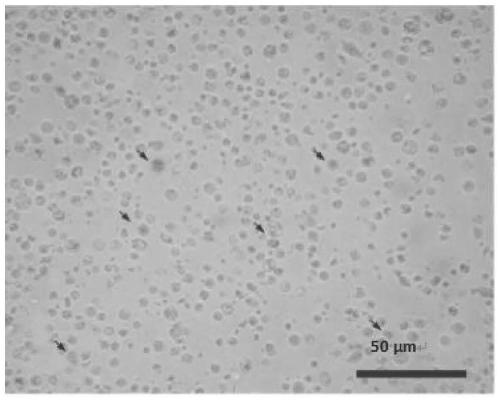Dissociation and separation method for shellfish spermary spermatogenic cells
A technology for spermatogenic cells and shellfish, which is applied in the field of separation of marine shellfish cells, can solve the problems of difficult separation of shellfish spermatogenic cells, and achieves the effects of large application value, high content and improved activity.
- Summary
- Abstract
- Description
- Claims
- Application Information
AI Technical Summary
Problems solved by technology
Method used
Image
Examples
Embodiment 1
[0047] Take the testes of Chlamys farreri in the proliferating stage, and cut the testes into 1mm after cleaning and disinfection 3 The small pieces were then digested with 0.1% collagenase IV, and then digested with 0.25% trypsin. The time of the two enzymes for digestion is shown in Table 1. The testis was dissociated to obtain a single-cell suspension of Chlamys farreri germ cells.
[0048] The results are shown in Table 1. The results showed that at 25°C, when the concentrations of the two enzymes (0.1% collagenase IV and 0.25% trypsin) were fixed, the number of cells obtained by dissociation of 0.1 g of testis gradually increased with the prolongation of the treatment time of the two enzymes. increased, but the viability of cells gradually decreased after dissociation. Among them, experimental group 1 (digested with 0.1% collagenase IV for 60 min and digested with 0.25% trypsin for 5 min) had the highest survival rate of cells after dissociation, which was 98.23%, but th...
Embodiment 2
[0054] 1. Obtaining single cells from the testis of Chlamys farreri
[0055] ① Treatment of testicular tissue
[0056] Select the proliferating male clamshell scallop with good vitality and slightly white testes, wipe the surface of the double shell with 75% alcohol to disinfect, and then dissect out the testis tissue in an ultra-clean workbench, use calcium and magnesium ion-free phosphate buffer for cells (1 ×CPBS) rinsed 3 times, transferred to citrate-modified phosphate buffer solution (1×CPBS solution) containing double antibodies (350IU / ml penicillin and 350IU / ml streptomycin) and soaked for 1 hour for sterilization and disinfection, and then rinsed with 1×CPBS solution 3 times, use ophthalmic scissors to cut the testis tissue into a volume of 1mm 3 Little pieces left and right.
[0057] ② Preparation of single cell suspension by two-step enzymatic hydrolysis
[0058] Collect 0.1g of the shredded testis tissue into a 2ml EP tube, add 1ml of 0.1% collagenase IV, digest...
PUM
| Property | Measurement | Unit |
|---|---|---|
| Diameter | aaaaa | aaaaa |
| Cell diameter | aaaaa | aaaaa |
Abstract
Description
Claims
Application Information
 Login to View More
Login to View More - R&D
- Intellectual Property
- Life Sciences
- Materials
- Tech Scout
- Unparalleled Data Quality
- Higher Quality Content
- 60% Fewer Hallucinations
Browse by: Latest US Patents, China's latest patents, Technical Efficacy Thesaurus, Application Domain, Technology Topic, Popular Technical Reports.
© 2025 PatSnap. All rights reserved.Legal|Privacy policy|Modern Slavery Act Transparency Statement|Sitemap|About US| Contact US: help@patsnap.com



